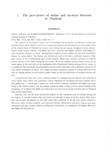The prevalence of maize and soybean diseases in Thailand
Country
Thailand
Technical bulletin of the Tropical Agriculture Research Center
| ISSN | 03889394 |
|---|---|
| NII recode ID (NCID) | AA00857848 |

Full text
techtarc12-_1-31.pdf4.03 MB
SUZUI, Takahito and KAMPHANGRIDTHRONG, Thanawatt, 1979, The prevalence of maize and soybean diseases in Thailand
Tech. Bull., Trop. Agr. Res. Center, Japan No. 12
The purpose of the present report was to investigate the prevalence of diseases of maize and soybean plants when upland crops such as maize and soybean are introduced into the paddy fields of the central plain of Thailand as second crops during the dry season. Sorghum downy mildew, brown stripe downy mildew, Curvularia leaf spot, southern leaf blight, northern leaf blight etc. were important diseases of maize. Among them, sorghum downy mildew was the most destructive disease for maize plants. The disease was distributed in all of the maize cultivated regions in Thailand except in the northernmost part of the country. There was a serious outbreak of sorghum downy mildew in the fields during the wet season. However, sorghum downy mildew burst out on maize plants in the test field at the Suphanburi Rice Experiment Station during the dry season. It is considered that inoculum was abundantly present in the field under the conditions created by all year round cultivation of maize. The fungus involved possessed conidia of a shape different from that of conidia present in Sclerospora sorghi found on the infected leaves of sorghum downy mildew.
Curvularia leaf spot was a very common disease in Thailand and the disease was observed in every region where maize was cultivated. Causal organisms of Curvularia leaf spot, namely Curvularia pallescens, C. lunata and C. lunata var. aeria could be isolated. Southern leaf blight was recognized in the whole country, but the disease appeared under a mild form in central Thailand. The prevalence of northern leaf blight was observed to be more severe in the northern part of Thailand than in the central plain.
Soybean rust was the most destructive disease for the cultivated area of soybean during the wet season. It became evident that rust broke out seriously in spite of the dry season when inoculum was present abundantly in the field under the conditions of all the year round cultivation. Moreover, other soybean diseases were bacterial pustule, Phyllosticta leaf spot, frog-eye leaf spot, Alternaria leaf spot, downy mildew, anthracnose, Sclerotium rot, Fusarium wilt/blight, Rhizoctonia blight and charcoal rot.
Tech. Bull., Trop. Agr. Res. Center, Japan No. 12
The purpose of the present report was to investigate the prevalence of diseases of maize and soybean plants when upland crops such as maize and soybean are introduced into the paddy fields of the central plain of Thailand as second crops during the dry season. Sorghum downy mildew, brown stripe downy mildew, Curvularia leaf spot, southern leaf blight, northern leaf blight etc. were important diseases of maize. Among them, sorghum downy mildew was the most destructive disease for maize plants. The disease was distributed in all of the maize cultivated regions in Thailand except in the northernmost part of the country. There was a serious outbreak of sorghum downy mildew in the fields during the wet season. However, sorghum downy mildew burst out on maize plants in the test field at the Suphanburi Rice Experiment Station during the dry season. It is considered that inoculum was abundantly present in the field under the conditions created by all year round cultivation of maize. The fungus involved possessed conidia of a shape different from that of conidia present in Sclerospora sorghi found on the infected leaves of sorghum downy mildew.
Curvularia leaf spot was a very common disease in Thailand and the disease was observed in every region where maize was cultivated. Causal organisms of Curvularia leaf spot, namely Curvularia pallescens, C. lunata and C. lunata var. aeria could be isolated. Southern leaf blight was recognized in the whole country, but the disease appeared under a mild form in central Thailand. The prevalence of northern leaf blight was observed to be more severe in the northern part of Thailand than in the central plain.
Soybean rust was the most destructive disease for the cultivated area of soybean during the wet season. It became evident that rust broke out seriously in spite of the dry season when inoculum was present abundantly in the field under the conditions of all the year round cultivation. Moreover, other soybean diseases were bacterial pustule, Phyllosticta leaf spot, frog-eye leaf spot, Alternaria leaf spot, downy mildew, anthracnose, Sclerotium rot, Fusarium wilt/blight, Rhizoctonia blight and charcoal rot.
| Date of issued | |
|---|---|
| Creator | Takahito Suzui Thanawatt Kamphangridthrong |
| Publisher | Tropical Agriculture Research Center |
| Volume | 12 |
| spage | 1 |
| epage | 31 |
| Language | eng |
